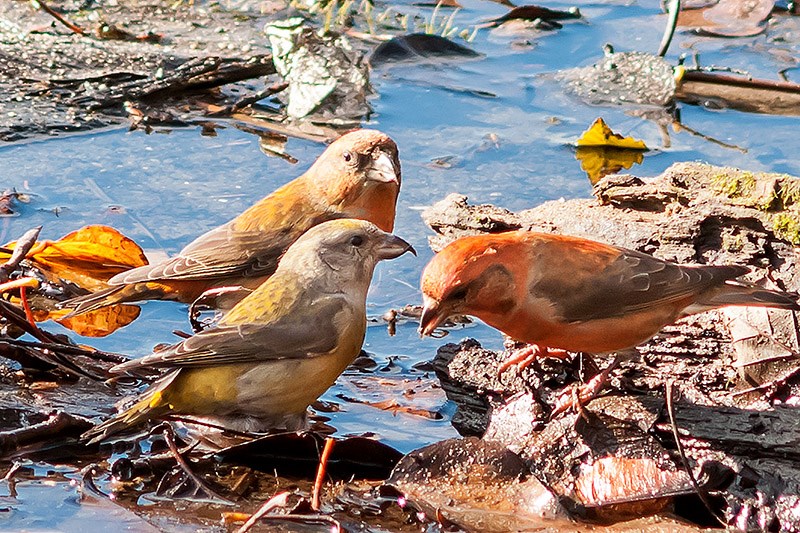On a gloriously sunny but somewhat nippy November morning, I joined a group of fellow Burke Mountain Naturalists for a stroll through the Shoreline Park in Port Moody. While most people may not pay much attention to the birds as they pass through this park, we were thrilled with all the wildlife we saw.
Our leader spotted a peregrine falcon keeping a watchful eye on the Inlet.
Several bald eagles had been attracted by the spawned-out salmon in Suterbrook Creek.
Noons Creek yielded a pair of brown creepers plus its usual American dipper, which was foraging for insects in the stream.
We observed more than a dozen killdeer sunning themselves on the mudflats. Butmost enchanting of all were the rare views we had of a small flock of red crossbills on the beach near Old Orchard Park on Moody’s north shore.
Red crossbills, slightly larger than song sparrows, are the type of bird birders never depend on reliably seeing in any one particular location — quite unlike the dippers, which are regular residents in the lower reaches of Noons Creek each winter. Crossbills are irruptive species, which means they are very nomadic in their habits and move in large numbers between areas in response to the availability of food.
Found throughout the coniferous forests of North America, crossbills don’t waste their time in areas where they can’t find their favourite food — the cones of several species of coniferous trees. With the most erratic breeding season of any bird in North America, they are equally unpredictable in their nesting habits. If they find a plentiful supply of food, they could start nesting by late winter, long before most other birds, and then move on once the supply of cones has been exhausted. With dark wings, the males are a muted red while the females have a more yellowish hue.
The name of the crossbills (we have two distinct species) comes from their crossed bills, which almost look like a deformity.
White-winged crossbills are more typically found in the Interior in coniferous forests where larch and spruce predominate. Red crossbills are found in forests along the coast including lower elevation areas.
Their crossed bills allow them to easily pry open the scales of a cone. Once they are opened, the crossbills then reach inside with their tongues to extract the seeds. (A video which shows white-winged crossbills opening spruce cones is available on YouTube; search “How Nature Works: White-winged Crossbill Feeding Technique.”)
Red crossbills show considerable variation in the size of their bills, which is related to the species of cones they eat. Ornithologists believe there are at least eight subspecies of red crossbills, each with its own distinctive call and bill size. For example, some crossbills are adapted to eat larger cones, such as ponderosa pine, while others, with smaller bills, eat the cones of western hemlock and Sitka spruce.
Crossbills and their close relatives, the red polls, have an additional adaptation that helps them survive the cold winters typical of most coniferous forests. These birds have a pocket compartment in their esophagus that allows them to store seeds. This means they can gather seeds throughout the day but eat them later at their leisure, once they have sought refuge from cold winds amongst the thick branches of bushy conifers.
Like several bird species, crossbills are facing some challenges. For example, there is thought to be a unique red crossbill subspecies in Newfoundland but the red squirrel that was inadvertently introduced to this island about 40 years ago now appears to be out-competing the crossbills for the cone supply. This is posing a grave risk to the continued survival of this crossbill.
In B.C., crossbills may be facing a similar threat. The logging industry is shifting to much shorter time periods between clear-cutting blocks of forests. Since many conifers do not produce large cone crops until they reach about 60 years of age, these shorter rotations will result in far less abundant food supplies for crossbills. As a result of this practice, only stands of mature trees in protected areas such as parks could remain as vital sources of food.
So what were the red crossbills doing on the mudflats near Old Orchard Beach, where there are few conifers? We surmise they were eating salt, which formed as the sea water evaporated under the intense glare of the sun. The crossbills’ diet of seeds tends to leave them somewhat deficient in minerals such as calcium. In winter, crossbills can sometimes be seen by roadsides, where they eat the salt that has been spread to melt ice. The need for salt in their diet probably explains why they are sometimes seen feeding on the ground along coastal beaches.
Next time you visit PoMo’s Shoreline Park, bring your binoculars and keep an eye out for some of nature’s charming vignettes, such as the unusual sight of these crossbills foraging on the beach.
--Elaine Golds is a Port Moody environmentalist who is conservation/education chair of the Burke Mountain Naturalists and member of the boards of the Colony Farm Park Association and the Port Moody Ecological Society.



